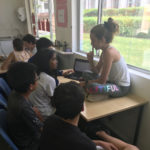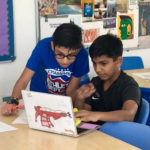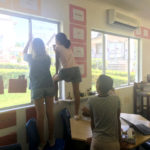At 62-years-old, my mother-in-law went back to school at the University of Minnesota. She was thrilled to be getting another degree and was excited about the courses she was taking. This was until halfway through her first semester when she called me and my wife to complain about “yet another group project”.
“Nobody else was prepared for our meeting! I ended up doing everything!” She exclaimed. “And I just don’t understand why I have to work with people I hardly know.”
She was vocalizing something that we have all felt at one point or another — frustration with group work. Of course, such challenges aren’t limited to students; teachers struggle with group work, as well.
Educator, blogger, and podcaster, Jennifer Gonzalez, recently posed a question on Twitter regarding the obstacles that teachers encounter when assigning group work.
Unsurprisingly, clear trends emerged in the more than 130 replies, ranging from issues of student accountability and the uneven distribution of work, to uncertainty around feedback protocols. Mainly, though, teachers expressed their frustration in composing balanced groups — a delicate and often tenuous exercise that has to account for academic standing, dispositional traits, and social-emotional compatibility.
Given the time-consuming task of forming groups, some educators confessed that they have altogether eliminated group work from their classes. While this response is somewhat understandable, eliminating group work isn’t the answer. We know from countless studies that collaboration is one of the most important 21st Century skills.
So, we must ask ourselves, “How can we preserve collaboration while reducing the headache of group work?”
For many teachers, the solution lies in having students select their own groups.
However, there are many obvious downsides to this approach. This runs the risk of leaving some students on the sidelines searching for a group. It also doesn’t necessarily best serve student learning, as students must work in lock-step with one another, irrespective of individual pace or preference.
For example, if students have to read a passage for their project, completing this step as a group probably isn’t the optimal approach. And yet, students don’t have the option to work independently, even on a single part of their project.
In defense of this approach, some teachers argue that it mirrors collaboration in the real-world, but that isn’t totally truthful, is it?
In a professional setting, we often have a choice about when to work independently and when to work collaboratively, and we make this choice depending on the task at hand.
Since any given project is comprised of multiple discrete tasks — each of which requires different forms of collaboration — group work in the real-world is often a dynamic, not static process.

One way to authentically replicate real-world collaboration in the classroom is through a flexible grouping model.
In a flexible grouping model, no assignment is explicitly independent or collaborative; instead the balance is struck by the learners themselves. By factoring in task, pace, and level of challenge, students can work independently, with a partner, or in small groups. Within a single class-period, multiple permutations may exist, as students make a new choice with every new instruction.
When students enter my classroom, the first thing they do is check to see where they left off last class. From there, they read the next instruction and make a decision about whether they want to work independently or collaboratively. Having made their choice, they signal it to their classmates with a paper cut-out of either the number 1 or 2: students use the 1 to signal to their classmates that they would like to work independently; students use the 2 to signal to their classmates that they would like to work collaboratively.
The fluid, organic nature of this system has myriad advantages over the more static traditional model of group work:
The development of metacognition and personal management skills
Metacognition and personal management skills are essential both in school and the workplace. Flexible grouping helps to develop these skills as students need to think about where they are in their learning, what the task demands, and how they learn best. Only when these questions are answered can students make a choice about whether to work independently or collaboratively. Over time, students begin to identify and refine their own best paths for accomplishing their work, as they begin to become increasingly aware of who they are as a learner.
Student-owned flexible learning spaces
When a student chooses to work independently or collaboratively, they must also make a decision about where to work. In this way, individuals, partners, and small groups must manipulate the environment to optimize learning. As you can see from the photos, students make personal decisions about where to work and truly make the space their own.
Peer experts
With flexible grouping, expertise becomes a public resource. In my class, there’s a list of skills I identify as being relevant to success on a given assignment. Over the course of their work on this assignment, students identify themselves as experts on one or multiple of these skills. Students who might be looking to collaborate can reference this chart and meet with a peer expert to engage in a conversation or run through a peer-editing protocol.
Learning, not lethargy
We know how powerful stasis can be, so students who start class working independently may be inclined to work independently for the entire class. For this reason, we have a saying in my class: “Learning, not lethargy.” The decision-making in flexible grouping is therefore not a once-off, but rather is an ongoing series of decisions. Students must make continual choices about whether to work independently, with a partner, or in a group, according to the instruction/task at hand, and not the project as a whole.
Learning comes first
When it comes to a traditional style of group work, students often have to deal with issues unrelated to their learning, including interpersonal relationships, absences, and groupthink. But with flexible grouping, the learning comes first. Students form and disband groups according to the task, so these issues are nullified.
But learning isn’t the only factor:
Especially in a middle school, we need to account for the social-emotional aspects of learning. Sometimes, students just need a little bit of alone time. In a flexible grouping model, students can work independently without drawing attention to themselves. For students who may be feeling a bit more social on a given day, they, too, can scratch this itch without disrupting learning. In this way, flexible grouping accounts for both introverts and extroverts.
When it comes to personalized learning, we’ve come a long way in allowing students choice in terms of the what, where, and when of their learning, but what are we doing to allow students choice when it comes to the “who”?




